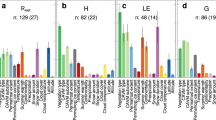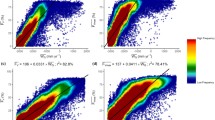Summary
Modelling and Geographic Information System (GIS) technology are employed in order to extend spatially, estimated and observed growing season values of the components of the surface heat energy budget for an area of alpine tundra in the Colorado Front Range. A surface equilibrium temperature model is calibrated for one sub-class of vegetation surface and is used to model surface heat energy budget component values for other sub-classes of vegetation. The model values compare favorably with values independently estimated or observed. The data are spatially displayed using the Idrisi GIS. At the microclimatic scale the presence of different sub-classes of vegetation plays a large role in controlling the actual values of the surface heat budget components. This is in contrast to the larger scale at which climatic variables such as air temperature control the overall vegetation type found in the area.
Similar content being viewed by others
References
Arnfield, A. J., 1979: Evaluation of empirical expressions for the estimation of hourly and daily totals of atmospheric longwave emission under all sky conditions.Quart. J. Roy. Meteor. Soc. 105, 1041–1052.
Avissar, R., Maher, Y., 1988: Mapping frost-sensitive areas with a three dimensional local scale model. Part I: Physical and numerical aspects.J. Appl. Meteor. 27, 400–413.
Brazel, A. J., Outcalt, S. I., 1973: The observation and simulation of diurnal evaporation contrast in an Alaskan Alpine meadow.J. Appl. Meteor. 12, 1134–1143.
Davies, J., Hay, J. E., 1980: Calculation of the Solar Radiation incident on a horizontal surface. In: Hay, J. E., Won, T. K., (eds.)Proceedings of the First Canadian Solar Radiation Data Workshop. Ministry of Supply and Services, Canada, pp.32–58.
Dickinson, R. E., 1984: Modelling Evapotranspiration for Three-Dimensional Global Climate Models. In: Hanson, J. E., Takahashi, T. (eds.)Climate Processes and Climate Sensitivity, Geophysical Monographs. Number 29. American Geophysical Union. pp. 58–72.
Dozier, J., Outcalt, S. I., 1979: An approach toward energy balance simulation over rugged terrain.Geographical Analysis 11(1), 65–85.
Geiger, R., 1965:The Climate Near the Ground. Cambridge, MA: Harvard University Press, 611 pp.
Goodin, D. G., Isard, S. A., 1989: Magnitude and sources of variation in Albedo within and Alpine Tundra.Theor. Appl. Climatol. 40, 61–66.
Greenland, D. E., 1984:Energy budgets over a moisture gradient in alpine tundra. Paper presented to the Annual meeting of the Association of American Geographers, Washington, D.C.
Greenland, D. E., 1989: The climate of Niwot Ridge, Front Range, Colorado, U.S.A.Arctic and Alpine Research 21(4), 380–391.
Greenland, D. E., 1991: Surface energy budgets over Alpine Tundra in summer, Niwot Ridge, Colorado Front Range.Mountain Research and Development 11(4), 339–351.
Greenland, D. E., Daly, C., 1983: Microclimatic data from the Saddle Area, Niwot Ridge, Summer 1982. University of ColoradoLong-Term Ecological Research Data Report, 83/8. 36 pp.
Greenland, D. E., Daly, C., 1985: Microclimatic data from the Saddle Area, Niwot Ridge, Summer 1984. University of ColoradoLong-Term Ecological Research Data Report, 85/4. 82 pp.
Greenland, D. E., Burbank, J., Key, J., Klinger, L., Moorhouse, J., Oaks, S., Shankman, D., 1985: The bioclimates of the Colorado front range.Mountain Research and Development 5(3), 251–262.
Greenland, D., Swift, L. W., Jr., 1991: Climate variability and ecosystem response: Opportunities for the LTER Network.Bull. Ecological Society of America 72, 118–126.
Halfpenny, J. C., Ingraham, K. P., Adams, J. A., 1983:Working Atlas for the Saddle, Niwot Ridge, Front Range, Colorado. CULTER/DR-83/1. Institute of Arctic and Alpine Research. University of Colorado, 24 pp.
Hare, F. K., 1973: Energy-based climatology and its frontier with ecology. In: Chorley, R. J. (ed.)Directions in Geography. London: Methuen, pp. 171–192.
Henderson-Sellers, A., 1990a: The “coming of age” of land surface climatology.Palaeography, Paleoclimatology, Paleoecology (Global and Planetary Change Section),82, 291–319.
Henderson-Sellers, A., 1990b: Predicting generalized ecosystem groups with the NCAR CCM: First steps towards an Interactive Biosphere.J. Climate 3, 917–940.
Isard, S. A., 1986: Factors influencing soil moisture and plant community distribution on Niwot Ridge, Front Range, Colorado, U.S.A.Arctic and Alpine Research 18(1), 83–96.
Isard, S. A., 1987: The effect of slope-aspect on turbulent transfer in an alpine fellfield: Niwot Ridge, Front Range, Colorado.Phys. Geogr. 8(2), 133–147.
Isard, S. A., 1989: Topoclimatic controls in an alpine fellfield and their ecological significance.Phys. Geogr. 10(1), 13–31.
Isard, S. A., Belding; M. J., 1989: Evapotranspiration from the alpine Tundra of Colorado, U.S.A.Arctic and Alpine Research 21(1), 71–82.
Komarkova, V., Webber, P. J., 1978: An Alpine vegetation map of Niwot Ridge, Colorado.Arctic and Alpine Research 10(1), 1–29.
LeDrew, E. F., 1975: The energy balance of a mid-latitude alpine site during the growing season, 1973.Arctic and Alpin Research 7, 301–314.
Losleben, M. V., 1983:Climatological data from Niwot Ridge, East Slope, Front Range, Colorado. 1970–1982. CULTER/DR-83/10. Institute of Arctic and Alpine Research. University of Colorado, Boulder, Colorado, 193 pp.
May, D. E., Webber, P. J., 1982: Spatial and temporal variation of the vegetation and its productivity on Niwot Ridge, Colorado. In: Halfpenny, J. C. (ed.)Ecological Studies in the Colorado Alpine: A Festschrift for John Marr. Institute of Arctic and Alpine Research. Occasional paper No 37. pp. 35–62.
Myrup, L. O., 1969: A numerical model of the urban heat island.J. Appl. Meteor. 8, 908–918.
Oke, T. R., 1987:Boundary Layer Climates, 2nd edn. London: Methuen, 435 pp.
Olyphant, G. A., Isard, S. A., 1987a: Some characteristics of turbulent transfer over alpine surfaces during the snowmelt — growing season: Niwot Ridge, Front Range, Colorado, U.S.A.Arctic and Alpine Research 19(3), 261–269.
Olyphant, G. A., Isard, S. A., 1987b: The role of advection in the energy balance of late-lying snowfields: Niwot Ridge, Front Range, Colorado.Water Resources Research 24(11), 1962–1968.
Outcalt, S. I., 1972: The development and application of a simple digital surface climate simulator.J. Appl. Meteor. 11, 629–36.
Sellers, P. J., Shuttleworth, W. J., Dorman, J. L., 1989: Calibrating the simple biosphere model for Amazonian tropical forest using field and remote sensing data. Part I: Average Calibration with Field Data.J. Appl. Meteor. 28(8), 727–759.
Swinbank, W. C., 1963: Long-wave radiation from clear skies.Quart. J. Roy. Meteor. Soc. 89, 339–348.
Terjung, W., 1969: Energy and moisture balance of an alpine tundra in mid-July.Arctic and Alpine Research 1, 247–266.
Author information
Authors and Affiliations
Additional information
With 6 Figures
Rights and permissions
About this article
Cite this article
Greenland, D. Spatial energy budgets in alpine tundra. Theor Appl Climatol 46, 229–239 (1993). https://doi.org/10.1007/BF00865710
Received:
Revised:
Issue Date:
DOI: https://doi.org/10.1007/BF00865710




